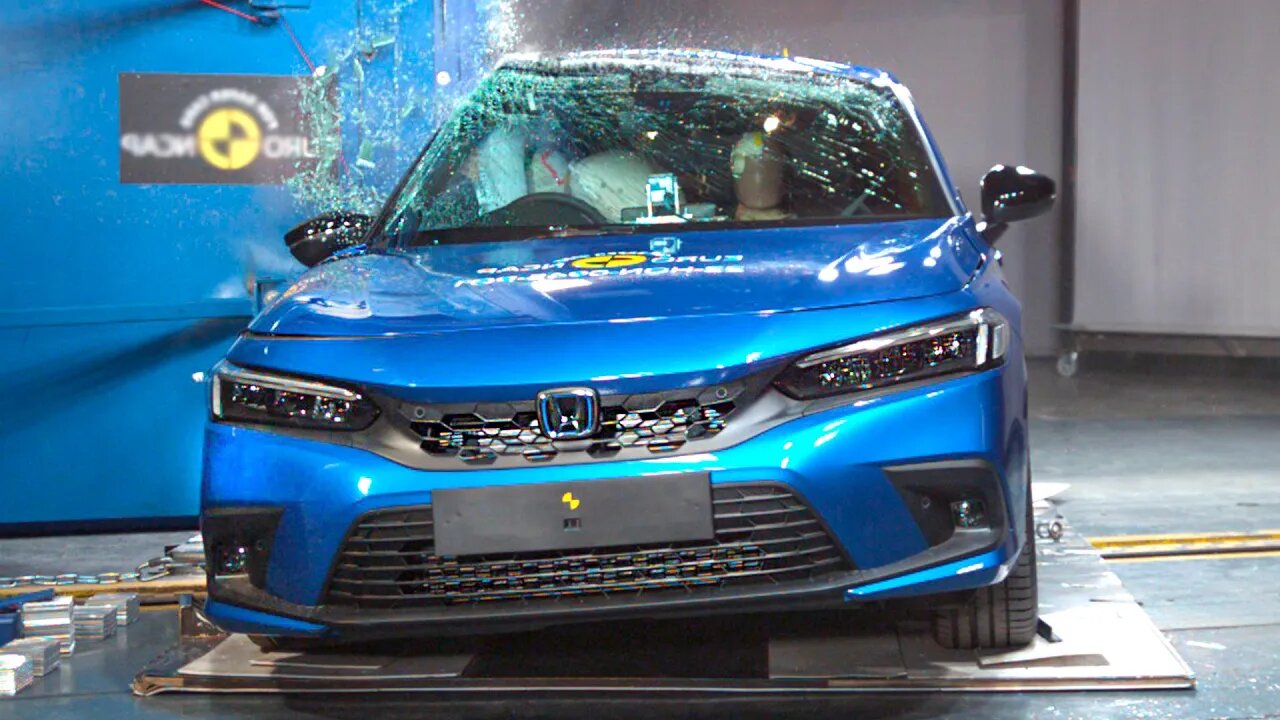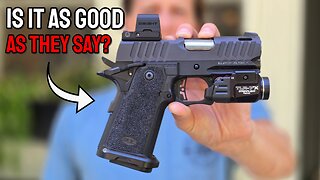Premium Only Content

Honda Civic (2023) Crash Test
The passenger compartment of the 2023 Honda Civic remained stable in the frontal offset test. Protection of the driver’s chest was rated as weak, based on dummy readings of compression. However, dummy readings indicated good protection of the knees and femurs of both the driver and passenger. Honda demonstrated that a similar level of protection would be provided to occupants of different sizes and to those sitting in different positions. Analysis of the deceleration of the impact trolley during the test, and analysis of the deformable barrier after the test, revealed that the Civic would be a benign impact partner in a frontal collision. In the full-width rigid barrier test, protection of all critical body areas was good or adequate both for the driver and the rear seat passenger. In both the side barrier test and the more severe side pole impact, protection of all critical body areas was good and the car scored maximum points in this part of the assessment. Control of excursion (the extent to which a body is thrown to the other side of the vehicle when it is hit from the far side) was found to be adequate. The Civic has a counter-measure to mitigate against occupant to occupant injuries in such impacts. The system performed well in Euro NCAP’s test, with good protection of occupants’ heads. Tests on the front seats and head restraints demonstrated good protection against whiplash injuries in the event of a rear-end collision. A geometric analysis of the rear seats also indicated good whiplash protection. The Civic has an advanced eCall system which alerts the emergency services in the event of a crash but it lacks a system to prevent secondary collisions in the event of an accident.
The Civic provided good protection for all critical body regions of both the 6 and 10 year dummies in the frontal offset and side barrier tests, and scored maximum points in this part of the assessment. The front passenger airbag can be disabled to allow a rearward-facing child restraint to be used in that seating position. All of the restraint types for which the Civic is designed could be properly installed and accommodated.
The Civic has an ‘active’ bonnet. Sensors in the bumper detect when a pedestrian has been struck and actuators lift the bonnet to create more space to the hard structures in the engine compartment. Honda showed that the system worked robustly for different pedestrian statures and across a range of speeds and the car was tests with the bonnet in the raised ‘deployed’ position. Protection of the head of struck pedestrian was almost entirely good or adequate. The bumper offered good protection to pedestrians’ legs but protection of the pelvis region was mixed. The autonomous emergency braking (AEB) system of the Civic can respond to vulnerable road users as well as to other vehicles. The system performed well in tests of its response to pedestrians and cyclists, with collisions avoided in most scenarios.
Do you like it?
Comment, like, dislike, share!
Subscribe now: https://goo.gl/5i54Vg
✅ Source: Euro NCAP
🎵 MUSIC used
Epidemic Sound ► https://bit.ly/2OvT1SC (30 days free)
Artlist ► https://artlist.io/JEAN-PAUL-784473 (60 days free)
-
 3:44
3:44
CAR TV
1 year ago $0.36 earnedWorld Premiere New NISSAN Hyper Force — Next-Gen GT-R Overview
7.01K4 -
 25:56
25:56
DeVory Darkins
18 hours ago $0.27 earnedTrump drops ULTIMATE BOMB on Democrat Mayors as ICE makes SHOCKING Announcement
17.9K115 -
 LIVE
LIVE
TonYGaMinG
3 hours ago🟢 ABI WITH FRIENDS | 🍩JOE DONUTS | 😶 🌫 VLADSGAMINGCARTEL |
76 watching -
 21:24
21:24
marcushouse
9 hours ago $0.06 earnedStarship Flight 10: Go or No? 🚀
8.66K9 -
 LIVE
LIVE
MrR4ger
14 hours agoSUNDAY FUNDAY w/ R4GER - VARIETY / DIABLO 4/ FOR HONOR / ETC?
90 watching -
 5:40
5:40
WhaddoYouMeme
3 days ago $0.16 earnedThey’re Calling This the End of Masculinity
11.4K13 -
 15:24
15:24
Tactical Advisor
18 hours agoBest 2011 of 2025 | Bul Armory Ultralight Pro
13.7K -
 27:31
27:31
True Crime | Unsolved Cases | Mysterious Stories
2 days ago $0.09 earnedThe Hong Kong Schoolgirl Mystery – 5 Mysterious Unsolved Cases (Part 8)
11.8K2 -
 7:19
7:19
China Uncensored
1 day agoChina is DONE in the South China Sea
10.8K26 -
 LIVE
LIVE
Joe Donuts Live
5 hours ago🟢 Loot Rats Unleashed: Arena Breakout Chaos! | Joe + Tony + Vlad
234 watching